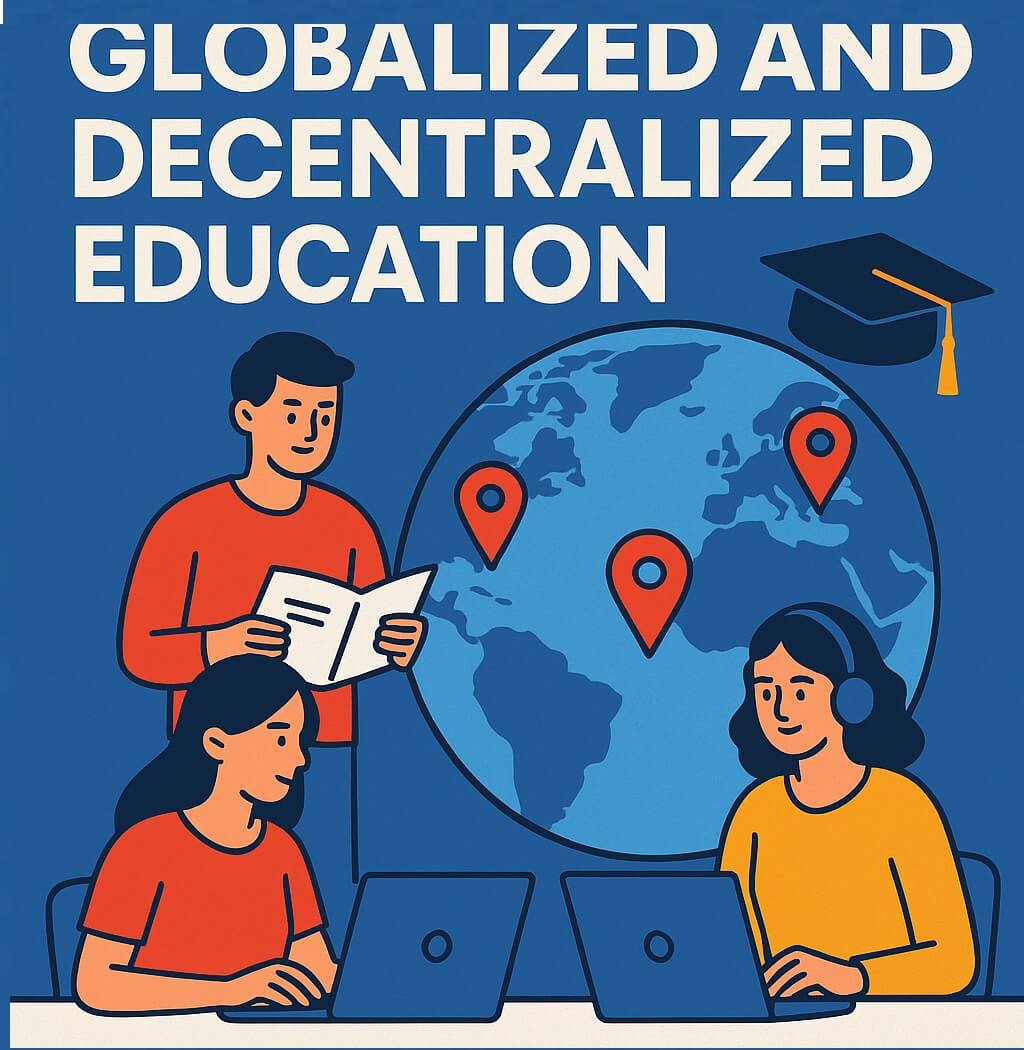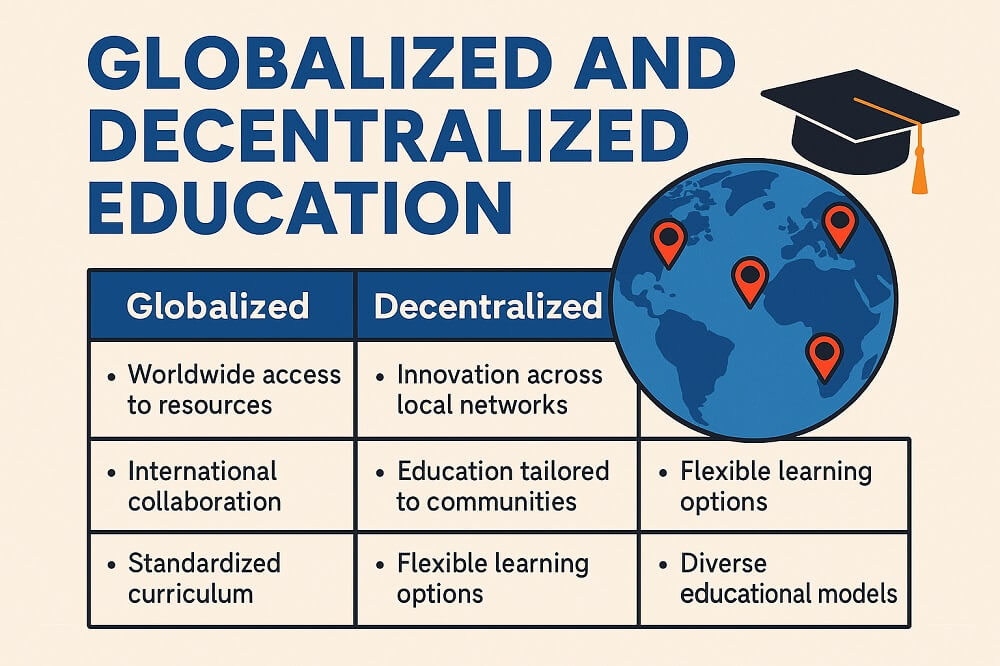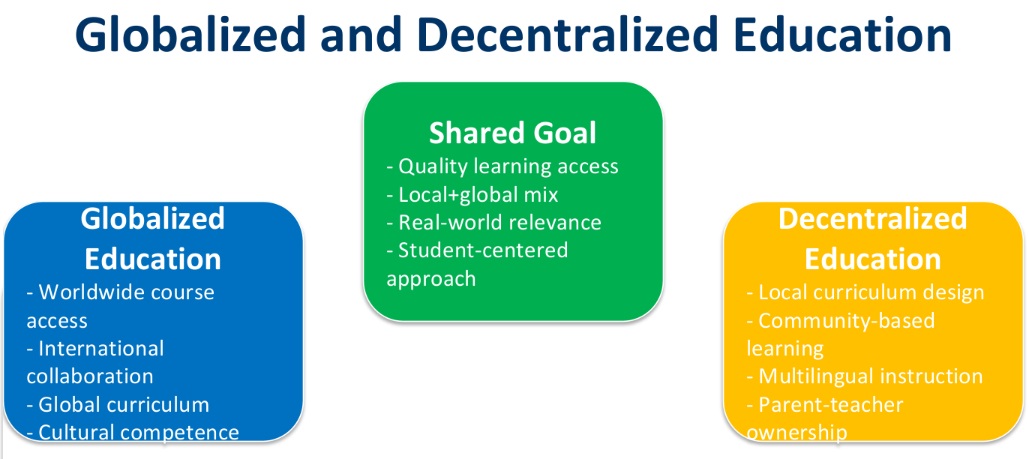
If you’ve ever felt like traditional education doesn’t quite fit your needs—or the needs of your students—you’re not alone. Many people worldwide ask the same question: What if learning could be locally relevant and globally connected?
That’s where globalized and decentralized education comes in.
We’re not just talking about watching online videos or joining virtual classrooms. This shift is more profound. It means giving learners access to global knowledge while letting communities shape how that learning happens. In this article, we’ll walk through what this model looks like, how it works in real life, and why it’s worth paying attention to.
Table of Content
- What is Globalized and Decentralized Education?
- How Education Has Changed Over Time
- What’s Driving Globalized Education?
- Why More Countries Are Choosing Decentralized Education
- How Globalized Education Helps Learners
- Why Decentralized Models Work for Many Communities
- Real-Life Examples That Prove the Point
- What Experts and Researchers Are Saying
- Numbers That Speak Louder Than Words
- What This Means for Learners and Educators
- How Policies and Infrastructure Can Support the Shift
- Looking Ahead: What Could the Future Hold?
- Final Thoughts: Let’s Keep It Real and Relevant
- FAQs
What is Globalized and Decentralized Education?

Making Sense of the Terms
Globalized education refers to learning that connects across countries and cultures—sharing ideas, content, and experiences beyond borders.
Decentralized education gives more power to local communities, educators, and sometimes even students. Instead of a single authority making all the decisions, schools and communities decide what works best for them.
Two Sides of the Same Coin
-
Globalized = Sharing and learning beyond borders
-
Decentralized = Local control and flexibility
Education becomes more inclusive, responsive, and meaningful when these two ideas meet.

How Education Has Changed Over Time
From Centralized Models to More Local Freedom
For a long time, education systems were run from the top. National ministries set the curriculum, testing standards, and teacher training rules. This system helped maintain order but didn’t leave much room for innovation or community needs.
That started to shift with technology, global cooperation, and a growing demand for personalized learning. Schools in different countries are now exploring more flexible models, prioritizing worldwide exposure and local relevance.
What’s Driving Globalized Education?
Technology as the Connector
UNESCO reported in 2023 that internet access has reached over 5 billion people, a massive leap from a decade ago. With just a phone and internet access, a student can attend a lecture at Stanford or take a certification course from the University of London.
More Students Studying Abroad
According to the OECD, more than 6 million students were enrolled in international programs as of 2023. Cross-border education has become mainstream, and schools are adapting by offering global coursework, virtual exchanges, and collaborative research programs.
Why More Countries Are Choosing Decentralized Education
Local Needs Matter
Not every student needs the same education. For example, a rural school in Kenya might focus on agriculture, while an urban school in South Korea might focus on robotics. Giving schools the power to adjust their curriculum based on student needs makes learning more meaningful.
A UNICEF 2022 report found that African students performed better and stayed in school longer when lessons reflected their language, culture, and community priorities.
Better Outcomes With Local Decision-Making
The World Bank’s 2023 report confirmed student performance improved when schools had more autonomy and community involvement.
How Globalized Education Helps Learners
Opening More Doors
-
Courses from global universities are available online
-
Students earn certifications that are recognized internationally
-
Exposure to a wide range of subjects and approaches
Building Global Skills
Students learn to work with peers from different backgrounds. They also improve their communication, critical thinking, and problem-solving skills, which many employers look for in international teams.
Why Decentralized Models Work for Many Communities
Making Learning Relevant
Teachers can adjust their lessons to make them more relatable. For example, in a coastal area, students might study marine conservation instead of farming. This would keep them interested and invested.
Involving Teachers and Parents
When local educators feel trusted, they’re more motivated. When parents see that the school reflects their values and challenges, they become partners in learning.
Real-Life Examples That Prove the Point
Finland’s Curriculum Freedom
Finland allows its teachers to design up to 30% of their school’s curriculum. The focus is on problem-solving, creativity, and collaboration. For years, Finland has been one of the top performers in global education rankings.
Online Platforms Going Global
Coursera and edX are now used by more than 124 million people. You can learn coding, psychology, or public health from professors at top universities. All you need is internet access and motivation.
India’s National Education Policy (NEP) 2020
NEP 2020 brought in major reforms. It promotes multilingual education, reduces standard exams, and gives state and local governments more control to design region-specific learning programs.
What Experts and Researchers Are Saying
-
Dr. Sugata Mitra’s “Hole in the Wall” project showed that children can teach themselves using the internet, especially when left to explore freely.
-
Harvard’s Global EdCast featured discussions about how employers now value soft skills, cultural awareness, and adaptability as much as degrees.
-
OECD Trends 2024 says hybrid models—mixing local values with global content—will shape education for the next generation.
Numbers That Speak Louder Than Words
-
Coursera has users in over 190 countries.
-
Fifty-eight countries are implementing decentralized school governance.
-
EdTech usage increased by 400% between 2020–2023.
-
Over 70% of future jobs will require digital and cross-cultural skills (World Economic Forum, 2024).
What This Means for Learners and Educators
More Choice, More Freedom
You don’t have to choose between local and global. A student in Kathmandu can learn AI from Stanford and then apply it to solve local transportation problems. That mix makes education practical and powerful.
A Better Fit for Today’s Needs
Instead of memorizing facts, students solve problems. Instead of following rules, they build important skills, such as teamwork, resilience, and self-motivation.
How Policies and Infrastructure Can Support the Shift
Public Sector Must Step In
Countries like Kenya, Nepal, and Brazil have begun decentralizing school decisions and adapting curricula to local needs. However, success depends on reliable internet, teacher training, and equitable funding.
Collaboration with the Private Sector
Partnerships with educational nonprofits and online platforms can bring world-class content into remote classrooms. However, the content must be contextualized to ensure it makes sense locally.
Looking Ahead: What Could the Future Hold?
A Hybrid Learning Culture
The ideal system balances flexibility with structure. It combines international content with local experience—digital learning with face-to-face mentorship.
Tech That Supports, Not Replaces
Tools like secure online certificates and adaptive learning apps can help schools manage assessments and personalize learning. But tech should serve people, not control them.
Final Thoughts: Let’s Keep It Real and Relevant
Education doesn’t have to be a one-size-fits-all deal anymore. We can create inclusive, practical, and future-ready systems with the right mix of global content and local control.
Let’s listen more to teachers, students, and communities. They know what works. Let’s make education something people want to be part of—not something they feel trapped in.
FAQs
1. What does globalized and decentralized education mean?
It means giving learners access to global content and learning experiences while allowing local communities to shape education.
2. How is decentralized education different from traditional models?
Traditional models are top-down, with national authorities controlling everything. Decentralized models give more decision-making power to schools and communities.
3. Is online education part of globalized learning?
Yes. Online platforms connect students to teachers and resources worldwide. They play a big role in global education.
4. What’s the biggest benefit of decentralized learning?
It makes education more relevant. Lessons reflect local culture, challenges, and goals—so students are more engaged.
5. Can schools mix both global and local education approaches?
Definitely. Many schools already do. It helps students get the best of both—local understanding and global opportunity.
Education




